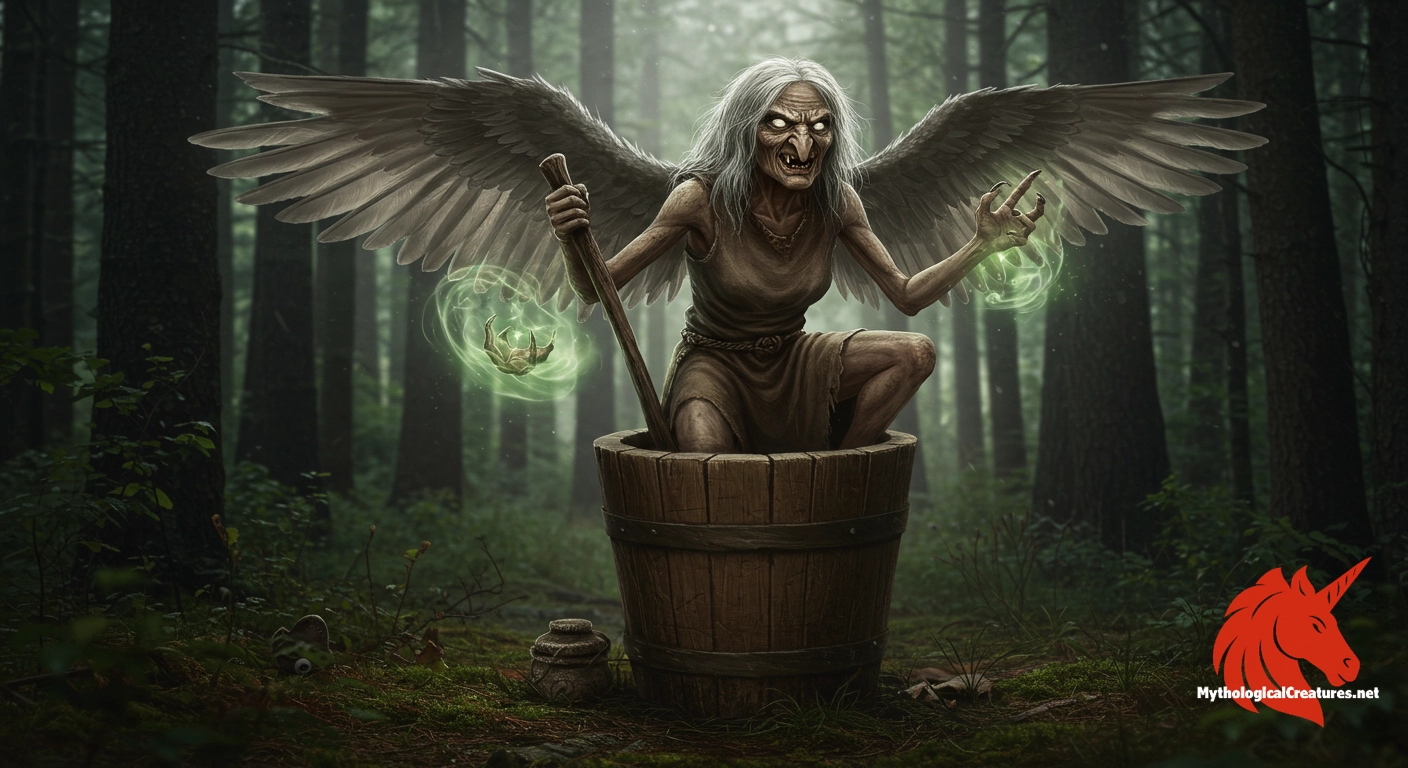Baba Yaga: Baba Yaga is an enigmatic witch from Slavic folklore known for her ambiguous nature.

Baba Yaga
Baba Yaga - Represents the duality of nature and the unpredictable forces of fate, serving as a threshold between life and death.
Origins & First Encounters
Baba Yaga emerges as one of the most enigmatic figures in Slavic folklore, embodying a dual nature that blurs the line between benevolence and menace. Born from ancient oral traditions, her origins are steeped in the wild, untamed landscapes of Eastern Europe, where the forest itself is a canvas for the supernatural. Her earliest attestations in folk narratives suggest a creature who both terrifies and aids, reflecting the deep ambivalence with which nature was regarded in bygone eras. Historical accounts portray her as an old woman whose wisdom and ferocity intertwine, making her as unpredictable as the forest storms. She occupies a liminal space between the mortal world and the domain of spirits, serving as a guardian to thresholds both literal and metaphorical. In many tales, her image is cemented by striking symbols, such as her flight in a wooden mortar and her peculiar pestle, which further magnify her mystical presence. Baba Yaga’s legend was shaped by generations of storytellers who laid a rich tapestry of myth and morality over her character. Her enduring appeal is a testament to the complexity and fascination of Slavic myth, where every shadow in the forest may hide a secret lesson or an unexpected guide.
Source Texts & Tale Variants
The multiple layers of Baba Yaga’s myth come to life through a diverse array of sources, ranging from ancient oral traditions to medieval manuscripts. Throughout centuries, her character has been reinterpreted in countless folk tales, each retelling emphasising a different aspect of her mysterious nature. These narratives, passed down through generations, often display striking variations, some accentuating her role as a fearsome entity, while others highlight her capacity to assist those who earn her favour. Early compilations of East Slavic folklore present her as a solitary figure whose actions oscillate between cruelty and unexpected benevolence. In many regions, the recounted stories also include legends of not just one, but several women sharing her name, each reinforcing the motif of ambiguity. Contemporary collectors of folklore have noted that the contradictions in her portrayal mirror wider cultural attitudes towards the unpredictable forces of nature and the passage of time. The layered accounts have been enriched over time by the contributions of regional storytellers, who have embedded local superstitions and beliefs into her narrative. This kaleidoscopic set of sources ensures that Baba Yaga's legacy remains a dynamic and multifaceted element of myth, continuously evolving with each retelling.
Form & Powers
Baba Yaga is vividly depicted in physical terms as a weathered crone whose appearance exudes both menace and ancient wisdom. Her face is often portrayed as deeply lined and scarred by the passage of harsh winters, evoking the relentless erosion of time. Dark, penetrating eyes are said to glimmer with a feral intelligence, hinting at her mastery over mystical forces. Descriptions frequently recount her dishevelled, tangled hair, which flows like wild brushwood, further symbolising her intrinsic connection to the untamed forest. In a manner that defies conventional gravity, she is famously known to fly about in a wooden mortar, an image that underscores her supernatural ability to traverse between realms. The pestle that accompanies her flight is not merely a tool but a potent emblem of her formidable magical powers, capable of both creation and destruction. Variations of her portrayal even suggest differences in her stature, with some accounts envisioning her as diminutive and animalistic, while others imbue her with a more imposing presence. Her attire, often depicted as ragged and decorated with natural elements like leaves and twigs, reinforces her seamless blend with the wilderness. The ever-intriguing hut on chicken legs, a recurrent element of her iconography, further roots her appearance in the surreal, where the boundary between animate and inanimate blurs amidst the magic of the forest.
Regional Faces
Across the expanse of Eastern Europe, Baba Yaga’s depiction undergoes subtle transformations that reflect regional traditions and local cultural ethos. In Russian folklore, she is predominantly seen as a solitary witch inhabiting the shadowy depths of ancient forests, symbolising a raw, untamed natural force. Ukrainian versions of the myth sometimes present her as possessing a more enigmatic and even nurturing aspect, blending fear with a cryptic form of wisdom. In Belarusian lore, the narrative often emphasises her dual nature, portraying her as both a formidable adversary and a potential guide through treacherous times. Local adaptations have introduced variations in her magical attributes and the mysterious architecture of her iconic hut, with distinctive embellishments that echo regional artistic motifs and natural landscapes. Some stories from the Carpathian regions, for instance, interweave her tale with elements of pagan ritual and ancestral veneration, suggesting an origin steeped in pre-Christian spirituality. Variations in her portrayal also underscore the regional attitudes towards the wilderness, transformation, and the supernatural. Through these diverse regional lenses, Baba Yaga remains a mutable myth whose core characteristics adapt to mirror the values and fears of each cultural milieu.
Cultural Parallels
When set against the backdrop of global myth, Baba Yaga clearly resonates with a number of archetypal figures, establishing her as a cornerstone of the witch and crone mythos. Similar to the hags found in Western European and Celtic traditions, she occupies an ambiguous role that blurs the line between wisdom and malevolence. The duality of her nature finds echoes in Nordic and Mediterranean narratives, where figures wield both nurturing and destructive forces. Her magical abilities and connection to nature draw parallels with other forest spirits and deities that inhabit the boundary between civilisation and wilderness. Just as the ancient wisdom of seeresses across diverse cultures often came with warnings of danger, Baba Yaga is emblematic of the perilous edge between order and chaos inherent in the natural world. Many modern reinterpretations have drawn comparisons between her and contemporary representations of the antiheroine, who challenges conventional moral boundaries. This cross-cultural dialogue highlights how her image has been adapted to suit various moral and societal paradigms. In comparative mythology, her multifaceted persona serves as an enduring symbol of transformation, power, and the timeless human fear of the unknown.
Legacy & Modern Evolution
The legend of Baba Yaga has undergone a remarkable transformation over the centuries, evolving in tandem with cultural shifts and narrative innovation. What began as an ominous figure in oral tradition has, in modern contexts, expanded into a symbol of both raw power and complex morality. Contemporary literature, film, and video games have all reimagined her as a multi-dimensional character who challenges simplistic notions of good and evil. Her timeless imagery—the mortar, the pestle, and the peculiar chicken-legged hut—continues to capture the imagination of artists and audiences alike, serving as a visual shorthand for the mysterious and the arcane. In modern reinterpretations, her once singularly fearsome persona is often nuanced with elements of empathy and enigmatic authority. This evolution mirrors broader societal changes in how age, gender, and the supernatural are perceived, transforming her from mere folklore into an enduring cultural symbol. Her story is frequently invoked in discussions about the nature of power, tradition, and subversion in modern media. As Baba Yaga seamlessly bridges the gap between the ancient and the contemporary, her legacy invites each generation to explore the layered meanings embedded in myth, ensuring that her story remains as captivating today as it was in the twilight of medieval forests.
Interesting Fact
Baba Yaga's paradoxical nature, oscillating between benevolence and malevolence, has made her one of the most intriguing and enduring figures in Slavic lore.
Quick Creature Info
Features:
Associations:
Our Mythic Legendary Rating:

Habitat:
Supernatural Powers:
Physical Attributes:
Abilities:
Behavior:
Lore:
Related Creatures, Tales or Lore
- CCailleach
- LLa Befana
- HHekate
References
Discover Another Mythical Legend You May Not Have Heard Of?
Uncover the mysteries of ancient folklore and expand your knowledge of legendary beings from cultures around the world.
Dare to Meet the Piuchén....
Mythical Disclaimer: The images and data on this site are derived from various historical and literary sources, but we have found that many myths often have multiple versions and interpretations across references, sometimes contradictory. As a result, these creature depictions are artistic interpretations—imaginative blends of folklore, legend, and a dash of AI guesswork. Because creature descriptions vary widely, our illustrations and accompanying information represent our best effort to honor mythology while bridging creative gaps. Enjoy these interpretations—just remember, we've done our best to respect the stories and validate available data, but in the realm of mythology, details often shift, imagination leads the way, and nothing is ever set in stone!
Curated by the Mythological Creatures Team (rev. May 2025)
